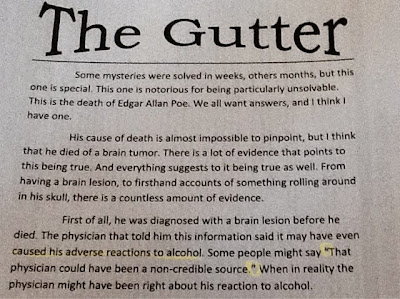The Top 5 Excuses for Missing Assignments and How I Manage it all for 100 students:
1. "I forgot it at home/in my locker/backpack/(insert place that is not in the classroom here)."
When I collect papers, I carry around a pad of post it notes. When a student has no paper to give me, I have them write the date and the assignment on the post it note and stick it in their box. The boxes are numbered to coordinate with student numbers and it serves as a visual reminder that they forgot something. When they get it later and turn it in, they take the post it note from the chart and stick it on their paper. This way I know it was late and I can easily spot a random paper that needs my attention. I also send a picture of the chart home on Class Dojo to all of the parents as a second reminder that there's a forgotten paper. They have until I check the grading complete box for the assignment on my online grade book to get it to me.
 |
| Missing Assignment Chart |
2. "I swear I turned it in!"-meet George
George doesn't write his name on his paper. He works really hard because he often does multiple copies of the same assignment. George has lots of missing assignments and will most likely fail my class. That's what the wall says. Those color coded magnetic pouches are where my students turn in their work. There are magnet clips on the wall labeled with George's name. I clip his papers there in the hopes that someone will see and claim them.
Who is this George guy anyways?
3. "I lost it."
I've seen lots of file systems for this purpose, but I repurposed my old BTSA box. I call it the "First Aid Kit" It's basically a small file crate with a handle. I hang it from the side of my desk with "S" hooks. There are file folders for each day of the week inside, and when I give out papers, I put the extras in there. This is also where the #5 student goes to get his/her work. There is a small binder inside where I put the paper copy of the agenda for the day. The student can go to the date/dates they were absent in the binder and see what they missed.
 |
| First Aid Kit |
4. "I didn't do it."
The student gives no apologies, no excuses, no promises to do it tomorrow. Unfortunately there are a few of these kids in every class. So what do I do with them, aside from grit my teeth and pull my hair out? The funny thing I've noticed about these kids is that when it's parent meeting time and you have to sit down and talk about less than spectacular grades, the story changes from "I didn't do it." to "I turned that in!" ... or my favorite "You never gave my that!" My solution to this student issue is the no homework binder. Students that don't make an effort to turn papers in, need to be accountable for that. So I have them write their name, the date and title of the assignment, and their reason for not doing it in the "No Homework Binder." It's pictured below, and each student has their own page in the binder where they document their missed work. This makes the unfortunate parent meeting more effective because you can skip past the "You didn't give me that paper!" and get right to "How can we fix this problem?" Better to solve the problem than play the blame game-keep the focus on solutions.
5. "I was absent."
This says it all! When you are done laughing, go back up to #3 and get your paper (first aid kit).
















































